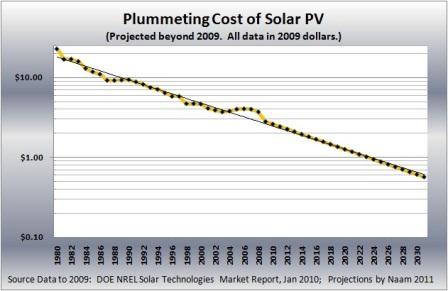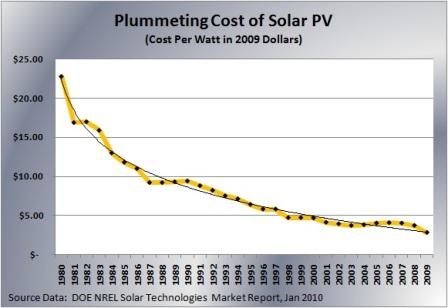 Does “Moore’s Law” hold for Solar Power?
Does “Moore’s Law” hold for Solar Power?
In New Jersey, between 2001 and 2010, we went from a total of six systems with a combined capacity of 9.0 KW to about 7000 systems with a combined capacity of 211,000 KW or 211 MW. This is illustrated below.

Increase from 9 KW in 6 systems to 211,000 KW in 7,000 systems. Copyright, 2010, L. J. Furman. All Rights Reseved.
This is the “hockey stick” curve of exponential growth typical of positive feedback mechanisms. I expect this kind of growth to continue for the next few years as prices drop, until solar meets 25% to 35% of New Jersey’s needs. This would be another 2500 to 3500 systems and about 200 additional MW in 2011 and 4000 to 5000 systems of 300 to 500 MW in 2012 , and brings me back to “Does ‘Moore’s Law,’ or a corollary, apply to PV Solar?” or “Is this a bubble?”
| PV Solar in NJ | |||||
| Year | 2001 | 2006 | 2009 | 2010 | 2011 |
| Systems | 6 | 2,042 | 4,000 | 7,000 | 10,000 |
| Capacity (MW) | 0.009 | 14 | 90 | 211 | 400 |
| Systems and Capacity over time. | |||||
| Data for 2001-2010 from NJ Clean Energy Program. | |||||
| Data for 2011 is an extrapolation | |||||
This exponential growth is fueled by exponential drops in the price performance ratio of PV Solar. Ramez Naam, in Scientific American, March 16, 2011, Paul Krugman, in the NY Times, Nov. 6, 2011, Joshua Gans on Digitopoly, November 7, 2011 and Eric Wesoff on Greentech Media, Nov 8, 2011 and Andrew McKeon, on Strategy+Business, Nov. 22, 2011, wrote about the applicability of Moore’s Law to the PV Solar industry. Naam added the “Plummeting Cost of Solar PV, with data from the DoE – NREL, also featured below.
The first curve, above, shows the data on a linear scale. This is the “Hockey Stick” of positive feedback mechanisms. The second graph shows the data plotted on a logarithmic scale.

PV Solar Module Cost Curve plotted on a logarithmic scale. NREL Data, presented by Ramez Naam in Scientific American
William Tucker, the author of Terrestrial Energy: How Nuclear Power Will Lead the Green Revolution and End America’s Energy Odyssey, ISBN: 0910155763, however, in “Paul Krugman Flunks Moore’s Law,” in the American Spectator, Nov. 15, 2011, wrote “There’s something about solar energy that turns otherwise intelligent brains to mush. Paul Krugman, the celebrated Nobel Prize-winning economist, has now joined the crowd…. In an op-ed last week entitled “Here Comes the Sun,” Krugman invoked Moore’s Law, of Silicon Valley fame, to marshal the case that solar energy will soon be taking the place of coal, oil, gas nuclear and all those other nasty things… What does all this [Moore’s Law] have to do with solar energy? Well, nothing.”
Who is right? Gans, Krugman, Naam, Wesoff, or Tucker?
In 2005, when there were, in New Jersey, fewer than 2000 systems and less than 14 MW of installed capacity, a 10 KW system cost $78,000 to $84,000 exclusive of incentives and rebates, depending on the installer and the sophistication of the buyer. Today, when there are close to 10,000 systems and a capacity approaching – or exceeding – 400 MW, a 10 kw System costs $54,000 to $60,000 – 20% to 30% less.
This 20% to 30% drop in the price of solar energy over the last 6 years is not “Moore’s Law.” (As posted on the Intel website, here, “Moore’s Law, states that the number of transistors on a chip will double approximately every two years.”) The drop in price of PV solar is, more rigorously, a corollary to Moore’s Law. But “Moore’s Law” is not a “law.” It was not passed by Congress or any legislative body. Neither is it a physical law; a law of the universe such as the law of gravity or the laws of thermodynamics as discovered by physicists, chemists, biologists, or other scientists. Strictly speaking “Moore’s Law” is a principle which engineers designing computer chips work to actualize. Intel comes close to stating this, “Intel, which has maintained this pace for decades, uses this golden rule as both a guiding principle and a springboard for technological advancement” [italics added].
And it makes sense that engineers designing PV solar modules would work to follow a corollary to Moore’s law, to make PV Solar modules faster, more efficient, to increase capacity of modules and simultaneously decrease manufacturing costs. (A subsequent post will present some recent breakthroughs.)
But there are systemic challenges to adaption of PV Solar on a societal scale. Two are intrinsic; one is cultural.
The intrinsic problems are:
- We need a lot of power – 1.0 kilowatts per person for 300 million people is 300 gigawatts.
- Solar doesn’t generate power at night or during certain types of storms.
The cultural problem is that:
- We buy power from large centralized sources, called electric utilities, such as Consolidated Edison, Public Service Enterprise Group, etc. And they generate it in large centralized facilities, such as the Indian Point and the Oyster Creek nuclear power stations and big coal plants. And the fossil fuel industry has a lot of money.
The intrinsic problems are easy to manage. Since solar doesn’t generate power 100% of the time, we need to look at solar as one of a set of integrated power generation techniques. Oyster Creek is a 600 MW facility. It can’t be replaced with solar because solar doesn’t generate power at night. To replace it with a new nuclear facility would probably require $6.0 Billion and six to ten years. To replace it with 600 MW wind and 300 MW solar generating system would probably require two to three or four years and a $3.0 Billion. Since we need a lot of power we need to start a widespread deployment campaign. This would address the cultural problems.
Since Americans have waged “Wars” on Poverty, Drugs, and Terrorism, perhaps we should wage a “War” on Fossil Fuel Dependence” or a “War to Save the Earth.”
Alternatively, we can continue to subsidize coal, oil, methane, nuclear power, following the principles demanded in Bastiat’s “PETITION From the Manufacturers of Candles, Tapers, Lanterns, sticks, Street Lamps, Snuffers, and Extinguishers, and from Producers of Tallow, Oil, Resin, Alcohol, and Generally of Everything Connected with Lighting” and pushing the environmental costs onto our children and grandchildren.
So what of Tucker’s arguments?
Tucker says “Moore’s law is about information.” Actually, this is incorrect. Moore’s Law is about the size and capacity of integrated circuits and the number of transistors that can be etched in a chip, and the amount of information that can be stored on a chip. Thus, personal computers didn’t exist in 1960, when Moore was designing circuits. Personal computers in 1980, like the Apple II, held 16 to 32 kilobytes of RAM. The first IBM PC, introduced in 1981, came with 16 K, and was expandable to 64, and soon 512K. Personal computers today, in 2011, like the MacBook Pro, can hold 2, 4, or 8 gigabytes (GB) of RAM. The computers of 1980 could hold a few pages of text with minimal formatting. Today’s personal computers can hold billions of pages of text, millions of photographs, or songs, thousands of hours of high resolution video, etc.
Tucker starts with an ad hominem attack on Scientific American: “As anyone who has read that once venerable magazine of late can tell you, it’s much more about politics than science.”
Next Tucker tries to redefine Moore’s Law, starting with a grain of truth “it describes the number of components that can be placed on an integrated circuit. Moore noted in a 1965 paper that the figure had doubled every two years from 1958 to 1965 and thought it would probably continue at that pace ‘for at least ten years.’ In fact it’s continued that way ever since and has now accelerated to once every 18 months.”
As I did, Tucker observes that “Moore’s Law is not a “Law of Nature,” like the Laws of gravity or thermodynamics. It is Tucker says, “only an empirical observation about our rate of innovation.” As noted above, Intel sees Moore’s Law as a goal. They try to make it a self-fullfilling prophesy. They use it as a guide for a positive feedback system in which design enhancements feed additional design enhancements.
Then Tucker gets to solar energy. “With present technology, we can convert 25 percent of this to electricity. If we could raise this conversion to 35 percent — a 40 percent increase — it would be a technological marvel. That’s a lot different than doubling every two years.” Actually, if you do the math, an increase of 45% a year is doubling every 2 years and why I suggest that a corrolary to Moore’s Law applies to PV Solar. (Actually, an increase of 40% is a doubling every 2 years, 2 weeks, Do the math. Start with 100 units. Add 40% in one year; you get 140 units. Add another 40% of 140 in the second year, you end up with 196 units. The next 4 units require about 4% of a year, which is about 2 weeks.
| Time (years) | 40% increase |
| 0 | 100 |
| 1 | 140 |
| 2 | 196 |
But where Tucker is completely mistaken is his conclusion: “So what does all this have to do with solar energy? Well, nothing.” In his article in Scientific American, Naam wrote “The National Renewable Energy Laboratory of the U.S. Department of Energy has watched solar photovoltaic price trends since 1980. They’ve seen the price per Watt of solar modules (not counting installation) drop from $22 dollars in 1980 down to under $3 today [in 2009].”
Tucker resumes his ad hominem attack, getting his facts wrong while going after Al Gore. Tucker refers to Al Gore’s book “The Earth in Balance.” Gore’s book is called “Earth in the Balance” (ISBN: 1594866376) not “The Earth in Balance”. This is a detail. But if you get the details wrong, you set yourself up for false conclusions. Sadly, and at risk of presenting something that sounds like an ad hominem attack, but is not, this is a predictable event from writers on “The American Spectator.” In getting the details wrong, Tucker sets up his false conclusion.
Tucker continues: “Somehow [Gore] got the idea that because computer chips and solar panels were both made from silicon, they would follow a similar trajectory. Even Silicon Valley entrepreneurs and venture capitalists seem to have gotten the bug around 2004 when they jumped into “alternate” technologies, proclaiming they would do for energy what they had done for computing.” (More ad hominem attacks.
This is precisely the idea. Because PV Solar Modules are similar to integrated circuits in that they are designed, manufactured, and mass produced, we expect that:
- the engineers who design the solar cells to design more efficient PV cells which will transform more photons of sunlight into electric current, and
- the engineers who design manufacturing processes will design more efficient manufacturing processes.
This is precisely how engineers at Intel make “Moore’s Law” a self-fullfilling prophesy and why Moore’s Law, or a corollary, applies to solar.
